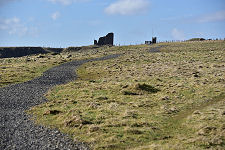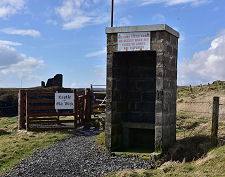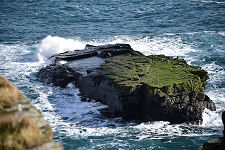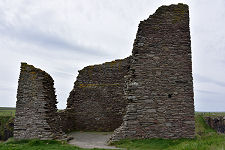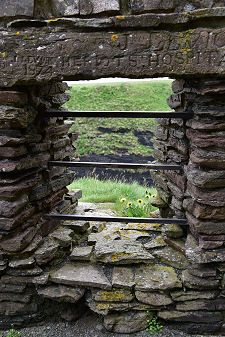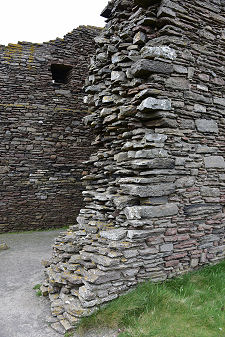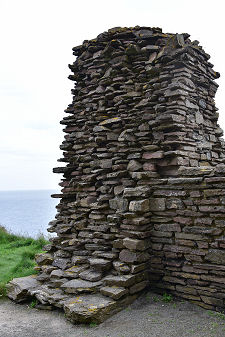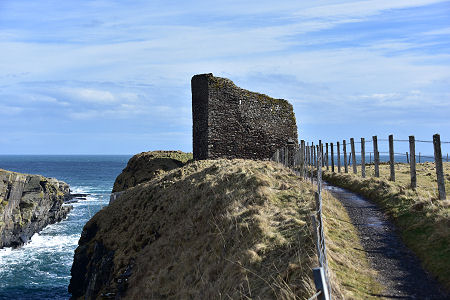 Approaching the Castle |
The Castle of Old Wick, also known as the Old Man of Wick, stands on the top of a sheer-sided promontory of rock projecting out into the North Sea between deep geos that ensure it is totally inaccessible from three sides. To reach it you follow signs through the south side of Wick to a coastal parking area near South Head. It is then a gentle uphill stroll along a smooth grassy track running parallel with the shore across a field. At the far side is a gate and a small guard post associated with what we think is a disused firing range which, if it were in active use, would prevent onward progress. On our most recent visit, in March 2024, access to the castle was prevented on safety grounds by signs and by a wall of Heras fencing across the promontory. Interior pictures on this page were taken on an earlier visit.
The castle is in view all the way from the parking area, but it is only once you pass the gate and guard post that you realise just how spectacular its location is. Until then the cliffs below the castle are hidden by the rising slope of the landscape. The total walk to the castle isn't much more than half a mile, and follows the near side of the northern geo before running around its landward end and approaching the castle from the west, passing what appear to be parts of the firing range en route. The final approach is along a path past an information board to the castle itself: and if you're at all scared of heights the spectacular location becomes more and more obvious the closer you get. (Continues below images...)
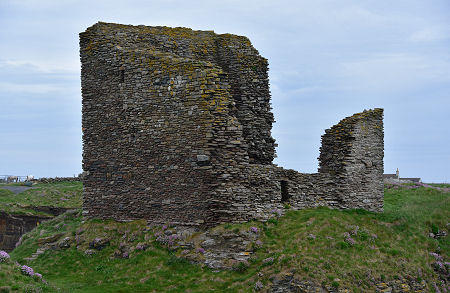 The Castle from the South-West |
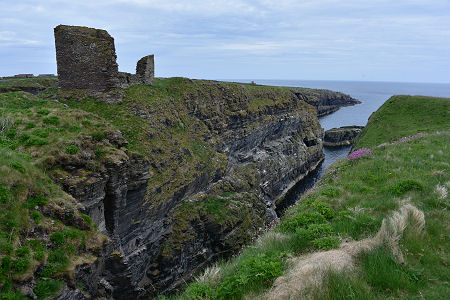 Wider View from the South-West |
It's perhaps as well that the Castle of Old Wick has such a spectacular location: if it didn't then you'd have to ask whether the ruins themselves, such as they are, actually warrant the expenditure of effort involved in a half mile walk. They say you should never judge a book by its cover and it is true that there is more to the castle than the massive square stone tower. Not an awful lot, though, and appreciating it takes a little imagination.
The obvious tower house was probably originally four storeys high. A dip on the access path a little before you get to the tower is all that remains of a stone-cut ditch that would have helped protect the only possible approach to the castle. The tower house was accessed via a door at first floor level on the side furthest from the approach. What is less obvious today is that much of the fairly flat area on the top of the promontory beyond the tower was surrounded by a defensive wall and there were ranges of buildings running along both sides of this area. To today's visitor, in summer certainly, this area is nothing more than a series of lumps and bumps under the vegetation. The geo to the north was used as a harbour to supply the castle.
The standing parts of the tower form a shell with evidence visible of places where at least one upper floor would have been supported. There's also some carved graffiti, one piece dated 1884. It seems that in those days you left your mark with a hammer and stone chisel.
Accounts of the history of The Castle of Old Wick differ significantly in some important details. We've gone with the Historic Scotland information board on the site which says that the castle was probably built by the Earl of Orkney and of Caithness, Harald Maddadson, in the 1160s. This was a time when the Norse influence in northern Scotland and the northern isles was very powerful.
The castle was held for the English by Sir Reginald le Cheyne, Lord of Duffus, in the Wars of Independence of the early 1300s. It was also besieged for eight days by the Earl of Caithness in 1569 before surrendering because of a shortage of fresh water. In 1604 it was sold by the Oliphant family of Berriedale to George Sinclair, the 5th Earl of Caithness. As it was only a few miles away from his main residence at Girnigoe Castle it was little used, and it became ruinous in the 1700s.
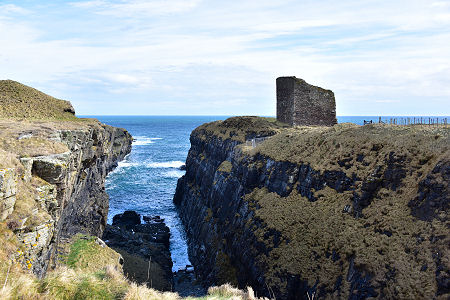 Castle of Old Wick and its Harbour |
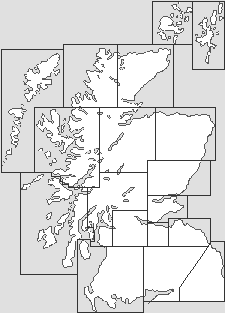
|
|
|
Visitor InformationView Location on MapGrid Ref: ND 369 488 www.historicenvironment.scot HES: Castle Web Page What3Words Location: ///shift.commander.lifted |
The Castle In Fiction
|
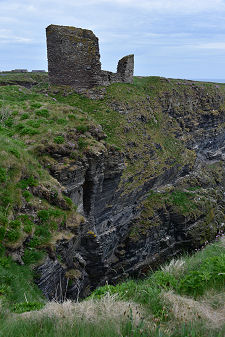 The Castle from the South-West |
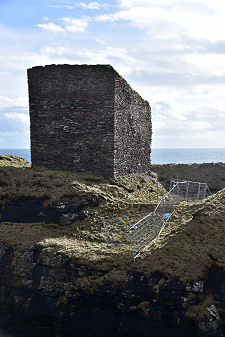 The Castle from the North |
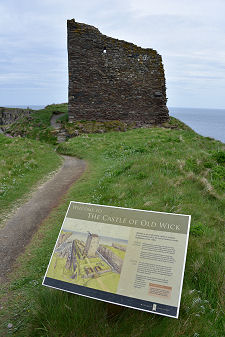 Approach Path and Sign |
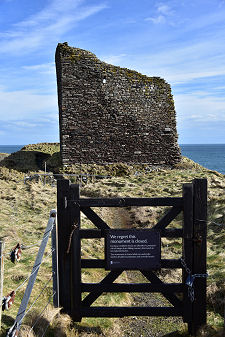 March 2024 - Monument Closed |
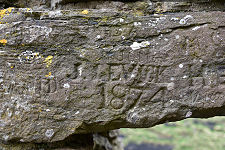 1874 Graffiti |
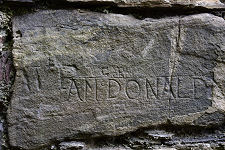 A. McDonald Was Here |
 Thicker Than Water by Ken Lussey (15 September 2024).
Thicker Than Water by Ken Lussey (15 September 2024).